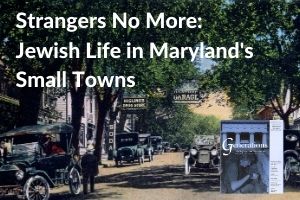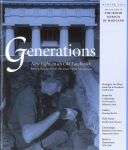Strangers No More

Jewish Life in Maryland’s Small Towns
 Written by Karen Falk, former JMM curator. Originally published in Generations – Winter 2001. If you would like to purchase a hard copy of this issue, please contact our shop, Esther’s Place, at 443-873-5179 or email info@jewishmuseummd.org.
Written by Karen Falk, former JMM curator. Originally published in Generations – Winter 2001. If you would like to purchase a hard copy of this issue, please contact our shop, Esther’s Place, at 443-873-5179 or email info@jewishmuseummd.org.
Stories about accidental arrival in a small town have the ring of folklore, depicting journeys that changed a family’s destiny. The truth, however, is that a Maryland Jew’s decision to open a business and raise a family far away from the region’s large Jewish communities in Baltimore, Philadelphia or Pittsburgh was usually made with careful consideration. The dreams that brought Jews to small towns and the realities they encountered there describe an important, but underreported, motif in American Jewish history,
Today, 95% of American Jews identify as urban and suburban people.[1] They live in and around cities with thousands of other Jews. An estimated 95,000 Jews, for example, currently live the greater Baltimore area. This large community is articulated into many branches: congregations that offer choices in style of worship; service organizations to assist special populations such as the elderly, new immigrants, and people with disabilities; a variety of educational institutions to instruct children, teens and adults; and an umbrella for them all, The Associated: Jewish Community Federation of Baltimore. A large community such as Baltimore’s also supports numerous private businesses that cater to specialized Jewish needs or preferences in food, clothing, and Judaica. Jews who live in this kind of community can choose to be aided in their spiritual, intellectual, and physical pursuits by private and communal organizations at every stage of their lives.

Jews’ tendency to cluster in urban areas was first documented in 1878, and the lives of urban Jews have been chronicled in literature ever since.[2] The image of the American Jew as an urban dweller is so pervasive, in fact, that most people find it difficult to imagine the existence of the 5% minority of Jews who live in small towns. Small communities, however, are enormously significant in the way they distill our understanding of Jewish identity in America.
It works like this: Jews in small towns must live without the enveloping communal institutions that sometimes insulate the city Jew within a comparatively homogenous group. They embrace participation in local pursuits, but at the same time define and demonstrate their cultural differences from non-Jewish neighbors through Jewish religious observances and cultural practices. These customs set Jews apart, reinforcing heterogeneity in the small town that typical American non-sectarian social and educational activities seek to erase. As citizens of small towns, Jews may feel themselves part of a warm and accepting community; as Jews in those towns, however, they may remain outsiders, strangers. Thus, these small communities provide powerful illustration of the influence of “place” on Jewish identity.
Just how big is a small community? Historian Lee Shai Weissbach, Professor of History at the University of Louisville, has defined small Jewish communities as those in cities and towns that have between 100 and 1,000 Jews. Historically, towns with fewer than 100 Jews (about 20 to 30 families) remain unfocused as communities, usually lacking the resources to build synagogues that become a marker of their presence.[3] Groups larger than 1,000 tend to break up and form sub-communities and begin to resemble the communities of larger cities in function and structure.
This pattern holds true in Maryland, with just a few exceptions. For example, the Jews in Brunswick, a small town on the Potomac that once bustled as an important railroad maintenance center, built a synagogue with fewer than fifteen resident families. At the other end of the spectrum, in Frederick, where the Jewish population has surpassed the 1,000 mark in recent years, the community has not yet subdivided, and gives every indication of continuing unity. Annapolis had a small Jewish community of fewer than 1,000 Jewish residents until the middle of the 20th century, and even today, when the Anne Arundel County community appears to number well over 3,000 Jews and supports several congregations and other Jewish organizations, residents still describe their community as “small town.” As Jewish populations in small towns wax and wane, several other Maryland communities now meet or at one time or another have met Weissbach’s population criterion including Frostburg, Cumberland, Hagerstown, Harford County, St. Mary’s County, Easton, Salisbury, and Pocomoke City.
Continue to Part 2: Jews Migrate to Small Towns (publishing on January 28, 2019).
[1] Marshall Klare, America’s Jews, Random House, 1971, p. 44.
[2] Jewish population date for c. 1878 is from Union of American Hebrew Congregations, Statistics of the Jews of the United States (Philadelphia, 1880). The Union of American Hebrew Congregations fortuitously conducted this survey on the eve of the mass migration of Jews from Eastern Europe, this establishing a benchmark for comparative population studies of Central and Eastern European Jews.
[3] Weissbach discusses his findings in a number of articles. A straightforward explanation of his decision to define as Jewish communities those locations with more than 100 Jews may be found in “Unexplored Terrain: The History of Small Jewish Communities in Western Society,” Shofar 17:1 (Fall 1998), pp. 59-71.
